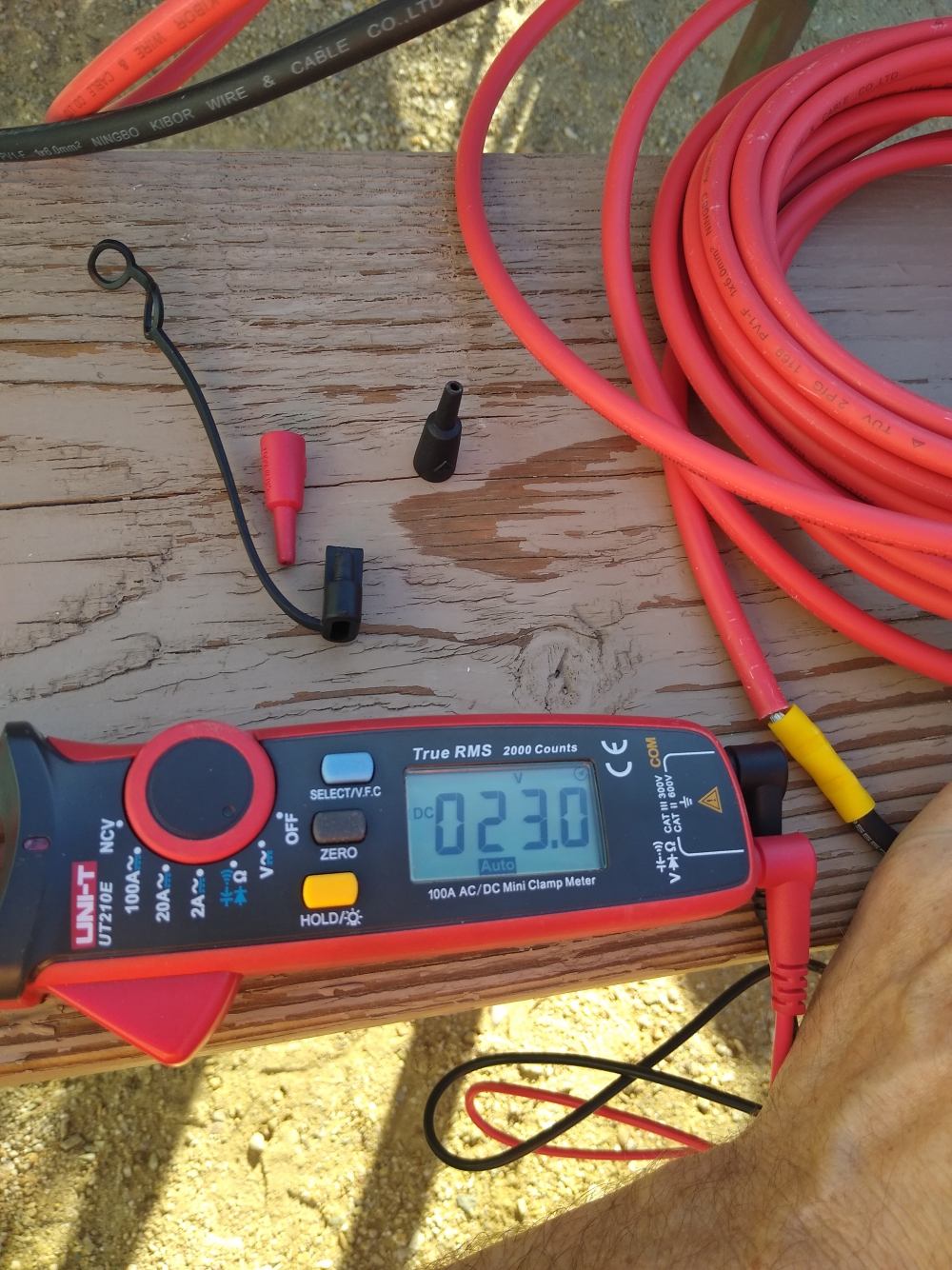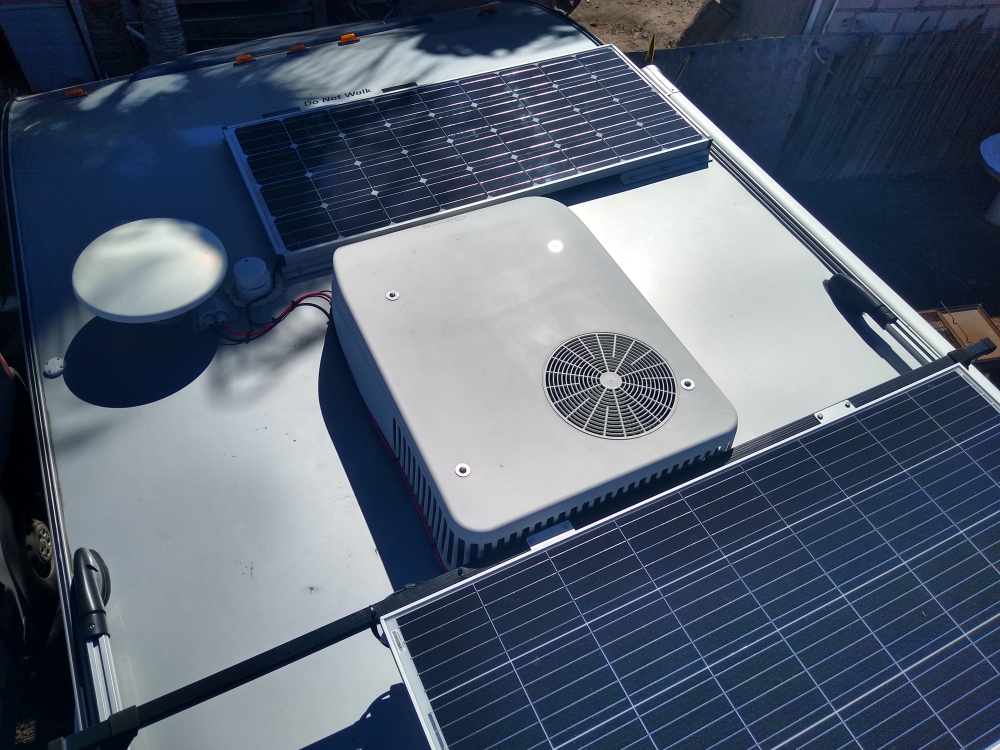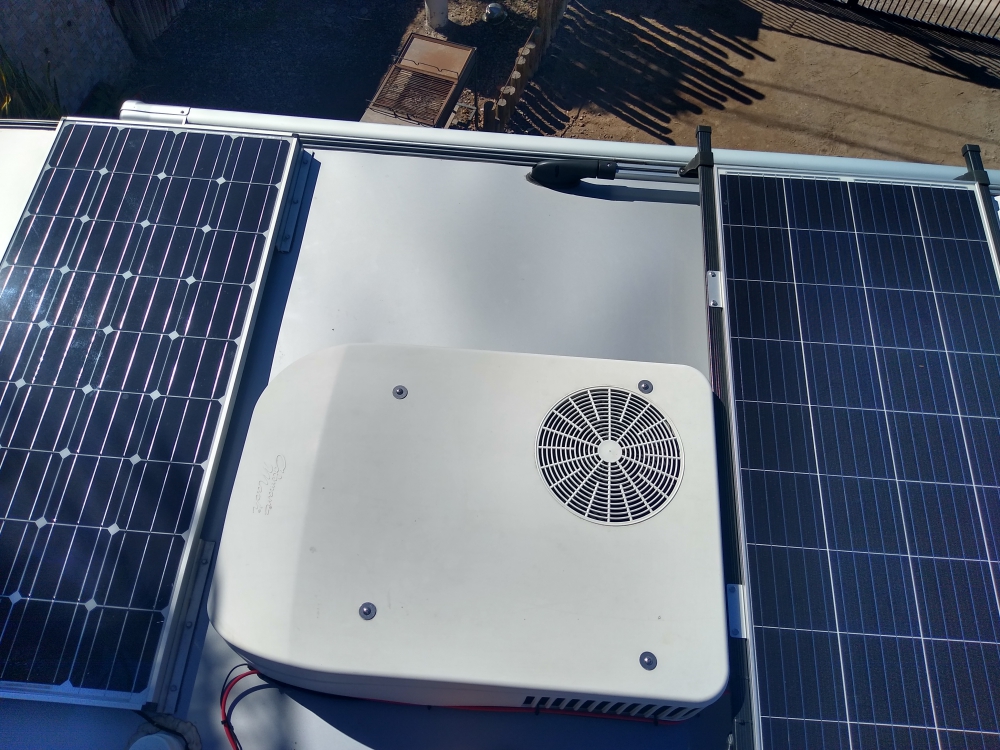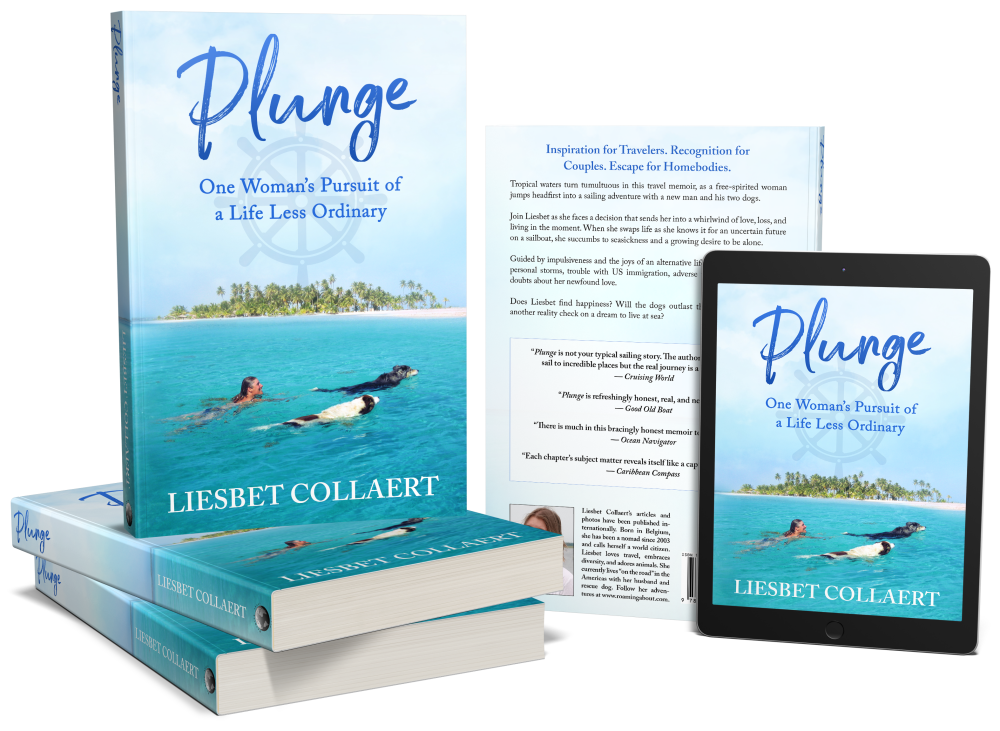Most of you already know that Mark, Maya, and I enjoy boondocking, also called wild or dry camping. This means we don’t utilize hook-ups (connection to electricity, water, and sewer), which are standard utilities at RV parks and most campgrounds. Not only is boondocking free (or affordable in official camping areas), but it provides us with privacy, space, and peace. We just love to spend our nights in solitude, surrounded by Mother Nature – a quiet environment, starry skies, the distant howl of coyotes.
Our RV has three tanks: fresh water for drinking, showering, dishes, and cooking; a “grey” tank to collect water going down the drains, and a “black” reservoir to collect contents from the toilet. We usually fill the fresh water tank and dump the others at dump stations. In Mexico, we buy our water at the “agua purificado” store. So, these essentials consist of the process “fill, use, dump, repeat.” But how about that other commodity called electricity? How do we collect and retain enough “juice” for our computer, lights, and few appliances? How do we manage to keep our devices charged when sitting still?
Ever since we owned our 35ft sailing catamaran Irie from 2007 to 2015, we have been fans of solar power. It allows us to be self-contained, free, and camp/anchor off the beaten path. If you are curious how that materializes in our current truck camper, Temp, please read on…
Mark and I recently installed an additional solar panel on the roof of our camper to augment the existing 160W panel that came with our “new” set-up. Last year, Mark built a 270Ah LifePO4 12V (Lithium) battery for Temp and we have been using that successfully for the past months. Our camper came with a Zamp Solar 160W roof-mounted solar panel and a Zamp Solar 30A PWM charge controller when we bought it last June. The charge controller does not work well with LifePO4 batteries, so changing that out was also on our to-do list to get the camper’s electrical system better prepared for full-time living.
We installed an additional 180W fixed solar panel from BougeRV (link here) to our existing roof rack. This avoided drilling new holes into the roof for the panel itself. We used the Z-bracket mounting hardware that BougeRV sells specifically for their panels, (see link here) which attached directly to the new 180W panel and then provided a horizontal surface to mount it on our roof rack. We also utilized their pass-thru gland for the new wiring into the camper from the roof (click link here), and received 30ft of 10AWG wire (see that link here).

Panel and accessories arrive

Unpacking the panel

Junction box

Inside junction box

Z-Brackets

30ft of 10AWG cable

Gland for camper roof
The panel itself came well-packaged and arrived damage-free. It had a protective layer of plastic over the aluminum frame and the glass portion was protected with a thin layer of foam. Our first test of the panel was to simply check if it was producing the rated output before installation, not connected to a charge controller. Mark did note that the specification label on the panel did not match the specifications on BougeRV’s website, but they were close enough to work well with our existing panel. The new panel performed as expected for this initial test, so we moved onto the permanent installation. The Open Circuit Voltage was 23.0V and the Open Circuit Current was 6.83A. This was with the panel angled to the sun, in December, so not an optimal time to test it in the northern hemisphere.

Specification label for panel

Open circuit voltage

Open circuit current
Because we had our roof rack already installed, mounting of the panel was fairly straightforward. Using the Z-Brackets, we laid the panel out on the rack and drilled 8 ¼” holes to match the ones in the brackets. We purchased separate bolts/nuts to mount the panel onto the rack, but the brackets did come with their own self-drilling/tapping screws that could be used depending on the installation.

Dry fitting the panel

Panel secured to the roof rack

Hardware included to secure panel to roof

Hardware included to secure brackets to panel
The next step was locating a suitable spot for the new 10AWG wire to pass through the roof and run to the location of our new solar controller. We were not able to re-use the existing gland and entry for the existing panel for two reasons: the gland would not accommodate 10AWG wire and its location was not suitable to run cables to the new controller. After determining an area next to our grey water exhaust vent that would work, Mark drilled two holes through the roof, one for each of the cables.
We removed the existing wire gland that was used for the existing solar panels and pulled the old wires up so Mark could work with those in completing the roof-top wiring. The cables from BougeRV came with a set of self-installable MC4 connectors which allowed him to connect the old panel to the new one, creating a waterproof and clean installation. Since the panels are wired in series, Mark ran the positive from the old panel inside, connected the negative from the old panel to the positive of the new panel (using the MC4 connectors), and led the negative from the new panel inside as well.

Wiring secured

Panel attached to the roof rack
Fortunately, the new roof holes were drilled in the correct location and it was just a matter of feeding the wires straight down in order to access them from inside and route them to the new solar controller. We applied a 3M sealant to the wire gland and then attached it to the roof with the included self-drilling/tapping screws. So far, no leaks!

Gland with new wires

Wiring from both panels connected before entering the gland
Inside the camper, we installed a new Victron 20-amp MPPT solar controller with Bluetooth (link to that product here). Since we already have a Victron SmartShunt (which you can find here) and DC-DC charger (link here) installed, it made sense to use additional Victron equipment.
Once we mounted the new solar controller, it was easy to connect the panel’s wires to it and then a short run of wires from there to our battery. The Victron charge controller uses Bluetooth and an app to configure it for your battery type. Once configured, the panels put out the power and the controller was feeding it correctly to the LifePO4 battery we have installed.
So far, we are very happy with the upgrade. It is winter in North America, so the sun is relatively low in the sky and our panels are mounted flat on our roof, so we know we are currently getting the worst likely output from the panels. That being said, with our total 340W-rated panels, we have seen a maximum output of 259W, which is 75% of the rated output. We are extremely satisfied with the performance of the new panel and the new solar controller. Once the sun is higher, we expect to see 300W on a regular basis.

340W of solar on our roof

Plenty of power!
All the components we installed have thus far worked flawlessly, and we would do the exact same install again if we had to. The parts from BougeRV and Victron work well together and the quality of all products has been top-notch.
If you are considering BougeRV solar panels – or other equipment – for your RV or boat, feel free to use the code ROAM12 for a 12% discount on any of their products. You can access their website here.
We are happy to answer any questions in the comment section.
(This post contains affiliate links. We earn pennies from qualifying purchases without extra cost to you.)





January 27, 2022 at 17:07
well that is awesome that your flowers can get a 12% discount on a panel – nice perk, Liesbet
–
I always marvel at how you and Mark are so handy and know (or learn) how to do so many installations. Enjoyed reading about how the panel was tested before installed (sounds obvious but some might forget this step – ha)
Also, the “wild or dry camping” really has some perks and glad this panel will allow you both to get off the grid and still get some electricity perks
🙂
~Yvette
January 28, 2022 at 15:50
Hi Yvette!
Thank you for your appreciative and encouraging words. We are exploring partnerships with companies to create win-win-situations for everyone on my blog. Mark is a handyman – I’m his assistant. And, he is a super meticulous person who is organized and goes through every step of the process in a dedicated, focused way. 🙂
Our main mode of camping has been off-grid and free. This would not be possible (for extended periods of time) if we wouldn’t have solar power. So, in a way, solar panels buy us freedom and peace.
January 27, 2022 at 17:41
I can change out the innards of a toilet but you lost me on installing electronics of any kind. Just glad you guys know how to do it!
January 28, 2022 at 15:51
Haha, Alex! I wouldn’t know how to do any of it – toilet innards or electronics! Mark is the expert. And, luckily, he doesn’t mind researching every project and using Google and YouTube to figure it out.
January 27, 2022 at 17:54
Wow, I’m glad you’re getting such a good output considering that you’re kind of in a worst-case scenario right now. I love the idea of solar power, and we’re looking into adding some panels to our house just to reduce our power consumption from the grid. But as we sit here enveloped in our 5th straight day of fog, I can see that it might be a while before any new system would pay for itself. 😉
January 28, 2022 at 15:56
Having solar panels is one more reason to travel – or live – in sunny countries. 🙂 That fog doesn’t sound attractive at all and for more than missed solar opportunities. If we ever have a house, we would love for it to be off-grid and just use mother Nature for all our needs. Well, except mother Nature’s fog…
January 27, 2022 at 17:59
That was fascinating–complicated but that’s because I don’t use them. I’m considering solar energy to run my generator but that’s a way’s off.
January 28, 2022 at 15:58
Wait a minute… Isn’t it either use solar (and batteries) OR a generator? I know a lot of people have generators as a back-up for when the power goes out (in houses) or when there isn’t sufficient solar or wind power to run their electricity needs. Or, when you need that extra boost of power to run heavier “equipment.”
January 27, 2022 at 20:25
There’s more detail here than I am able to absorb. Suffice it to say that I’m proud of you for staying off the grid and ON with solar power. May your tribe increase, Liesbet! 😀
January 28, 2022 at 15:59
Hi Marian! Much of this is above my head, too. Mark did a good job explaining the process and how we went about it. Mostly, how he went about it and I assisted. 🙂
January 27, 2022 at 21:53
Thanks for this detailed, step by step review!
January 28, 2022 at 16:00
Our pleasure, Margie. I hope it was explained in a simple enough way for most people.
January 27, 2022 at 23:55
Hi, Liesbet – Man, you know a lot about this stuff!! I echo Marian’s words — I greatly admire you for staying off of the grid and for using solar power as your main source of electricity. I also admire you for many others reasons…but I will save those for another post!
January 28, 2022 at 16:05
You are too kind and sweet, Donna!
We LOVE the off-grid lifestyle. It provides us with heaps of freedom, natural beauty, and peace. And, for the record: I know close to nothing about this topic. Mark wrote the article and I “cleaned it up,” adding introductory paragraphs. I should probably sign this blog post with his name. Some themes in WordPress allow you to add the author name to the post, but I didn’t see that option with mine. This might be his only post on Roaming About, though. 🙂
The other day, another RVer asked me what our solar output was and only thanks to revising this post, could I provide him with an answer. By tomorrow, I will have forgotten again.
January 28, 2022 at 17:07
Very impressed!
January 28, 2022 at 17:11
Well, thanks you two! 🙂
January 29, 2022 at 13:43
Hey Liesbet, I am curious how big your liquid tanks are on the new set up. Are they the same size as the van or has that been an additional adjustment? And you mentioned getting drinking water separately. Am I right to assume that is carried separately? How many gallons of fresh do you typically carry? We’ve been dry camping at a friend’s house (but they have electric and we can refill our water tank), and I am blown away by how fast we can go through tank space. I’m curious how you guys manage it so well.
January 29, 2022 at 14:46
Hi Laura,
Our tanks are a bit bigger now, in the truck camper than in Zesty. The fresh water tank is 38 gallons (as opposed 30 in the van), gray tank is 32 gallons, which is never a problem as we installed a “trickle valve” to dispose of it that way if necessary. The black water tank is 18 gallons now, which seems huge compared to Zesty.
If we are careful (using nature and public toilets as well), the black easily lasts two weeks. Our fresh water tank lasts at least one week, when we both take a shower every other day. I think we’d be able to go ten days, if the camper is level. But, once it’s not, the pick-up hose is not doing its job… Before we go to South America (if we keep this camper), we would like to carry extra water somehow, somewhere.
In the US, we just fill our fresh water tank at (usually free) dump stations – just like you get water at the campgrounds. We have a really good inline filter under the sink. When in Mexico, we buy our water at “purified water” places who have a long hose to reach our fill opening. This way, we can keep drinking from the tap. And, it’s easier than buying those 5-gallon jugs.
We’ve been careful with water for over a decade, something we learned on our sailboat. What annoys me most now is that Maya’s bowl gets so dirty and we end up tossing a lot of “hairy” water, which is a waste. This didn’t happen in the van, because we had more floor space and a better spot to put it. Also, it is important to shower military style and have a good shut-off valve – that you can adjust the water pressure with as well – on the shower head.
January 29, 2022 at 14:29
I don’t pretend to understand the detail, but I will say – good job! John would follow it, he’s my resident handy person. It’s very useful to have one, isn’t it?
January 29, 2022 at 14:47
It is very useful to have a handyman in the (moving) house, Anabel. I wouldn’t know what to do without my IT guy, plumber, electrician, and cook. 🙂
January 30, 2022 at 13:36
I think there is a misconception with regard to people – like Mark – who can make and fix things. Contrary to popular belief they weren’t ‘born’ with these talents… While they probably have some natural technical and/or mechanical aptitude there’s much more to it!
Necessity is not only the mother of invention but repair as well:-) For example: If you’re far from the nearest service center or unable to afford it then it’s necessary to make it or fix it yourself. I might add that even if you can find a service center and you can afford it then it’s doubtful they’ll make it or fix it correctly…
DIY ( do it yourself ) is more about attitude than aptitude. If you can’t work up the courage, IE: a ‘can do attitude’ then no amount of aptitude will get the job done. But even with all the tools, parts, aptitude and attitude you still need to educate yourself. Honestly – I wonder how DIY’ers ever managed before the internet. There’s a wealth of information – and misinformation – just a key click away. The hard part is separating the wheat from the chaff:-)
Even with all the resources of the internet at you finger tips there are many things that can only be learned through the school of ‘hard knocks’:-) The more things you make and fix the more skills you acquire. But along the way you’re going make mistakes that will cost you in not only time, energy & money but probably blood, sweat & tears! Chalk it up to the ‘high price of education’:-)
Making and fixing things falls into two distinct categories. Nice to have and mission critical. The latter is tougher. When ‘failure is not an option’ the stress level goes through the roof! That’s when believing in yourself and having a ‘can do attitude’ is most challenging, yet essential to getting the job done. I might add it’s also the worst possible time to have someone second guessing your every move!
So while I second all the positive comments with regard to Mark’s efforts I feel compelled to suggest that anyone can do it if they approach the problem with a ‘can do’ attitude:-)
January 30, 2022 at 14:00
Hello John!
Thank you for those true words and your input on this topic. I kept nodding my head when reading through your observations and statements.
Mark, indeed, had to learn all these “trades” by doing them and as issues appeared and, like you, he would have had a much harder time without the internet. When we were on our boat, he had “mechanics” handbooks he would use, but of course not every system or engine is the same.
Aptitude and attitude seem to go hand in hand when you live on the road or on the water. I also agree with you about (not) hiring “professionals”. Let’s just say we’d rather do everything ourselves, whenever we can.
Thank you for adding to the conversation and for your wisdom. I mean aptitude. 🙂
February 5, 2022 at 21:14
Solar power is the way to go when boondocking, for sure, Liesbet! When we got the new trailer in 2018 and had the RV retailer install the rooftop solar it was worth the expense of doing so especially when we could charge our devices with 9-volt plugs! I forget what our trailer’s solar panel wattage is, but it keeps lights on even when we experienced cloudy, foggy days. It even worked when we had a tarp covering the panel while in storage 2 years ago showing 80% power! I know Mark is VERY good at taking care of these things which no doubt keeps your expenses down. For us it was a one-time necessary expense that Hans couldn’t do due to time constraints. Thanks for showing us how it all works and glad to read you can exist without hook-ups for extended lengths of time. Well Done!
February 6, 2022 at 13:05
Good to know you two enjoy having solar as well. We swear by it. Right now, in sunny Baja and without using our computers much, our battery is already full by 10am. I feel like we need more electrical gadgets with all that power. 🙂 And a compressor fridge instead of a propane one.
February 13, 2022 at 21:59
So technical. The panels look good on your roof.
February 16, 2022 at 00:42
I agree! Too technical for me. That’s why I just edited, proofread, and posted this article. 🙂